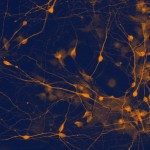Link to Pubmed [PMID] – 19793989
J. Neurosci. 2009 Sep;29(39):12302-14
Postdevelopmental neurogenesis occurs in the olfactory bulb (OB), to which new interneurons are continuously recruited. However, only a subset of the adult-generated interneurons survives, as many undergo programmed cell death. As part of homeostatic processes, the removal of new neurons is required alongside the addition of new ones, to ensure a stable neuron number. In addition to a critical role in tissue maintenance, it is still unclear whether this neuronal elimination affects the functioning of adult circuits. Using focal drug delivery restricted to the OB, we investigated the significance of programmed cell death in the adult OB circuits. Cell death was effectively blocked by the broad-spectrum caspase inhibitor benzyloxycarbonyl-Val-Ala-Asp(OMe)-fluoromethylketone (zVAD). The zVAD effect differed with newborn interneuron location, either in the superficial (periglomerular cells) or in the deep (granule cells) OB layers. Furthermore, whereas sensory experience potentiated the effect of zVAD on the survival of new granule cells, it had no additional effect on the survival of new periglomerular cells. Thus, distinct mechanisms control the survival/elimination decision of newborn interneuron subtypes. However, zVAD had no effect on the olfactory sensory neurons projecting to the bulb. Remarkably, psychophysical analyzes revealed that a normal rate of new neuron elimination was essential for optimal odorant exploration and discrimination. This study highlights the importance of cell elimination for adjusting olfactory performance. We conclude that adult-generated OB interneurons are continually turned over, rather than simply added, and the precise balance between new and mature interneurons, set through active selection/elimination processes, is essential for optimizing olfaction.
